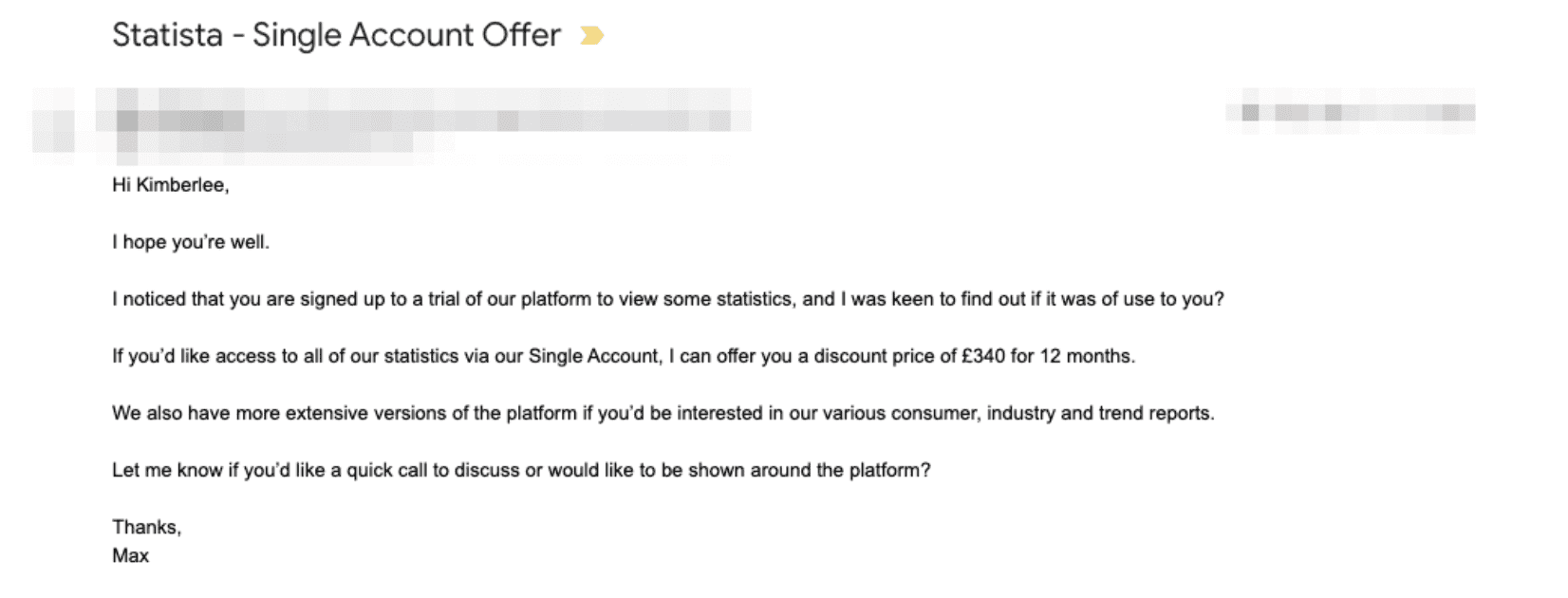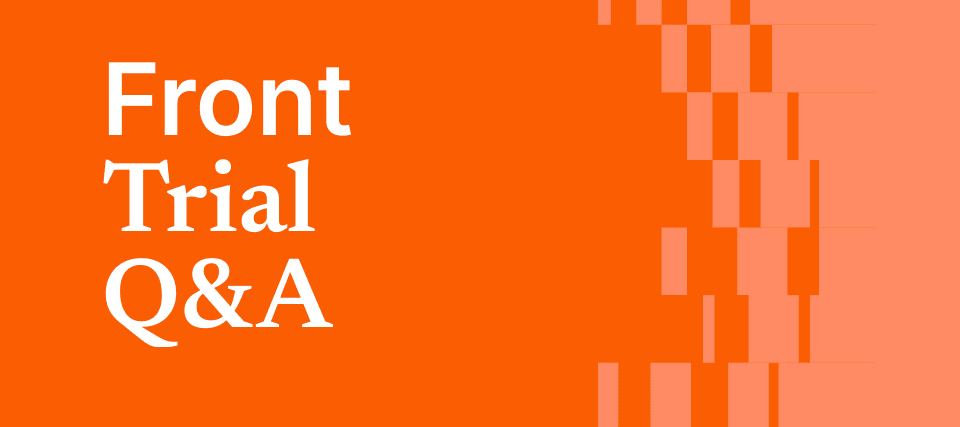Ever had a friend send a text after spending time together, just to say, “Thanks for the fun day,” or, “I’m just checking in to see how you’re feeling about that conversation we had,” or, “I thought of what happened earlier when I saw this article!” It’s genuine and makes you feel good.
We think of following up with customers the same way.
Following up is a tool you can use to get your customer’s attention after they start using your product or follow-up on a sales call—but it’s also just something that shows you care about the relationship. You’re invested.
Part of this is how we are talking to our customers. Email and phone will always have a place in how we sell to people and nurture our customers, but they now want the option to reach out on their preferred channel. Expanding your omnichannel approach—and communicating with customers the right way on every channel—is an important piece of the puzzle.
Let’s look at the best ways for customer success and sales departments to follow up with customers as if they’re your friends.
How to follow up with customers
The best way for sales departments to follow up
Keep it genuine and straightforward
As a sales person you’d never pass up sending an email after giving a demo of your product. The follow-up is critical. But you don’t have to overthink it: the best way to follow up (hopefully sooner rather than later) is to keep it simple. Messages written at a third-grade reading level are 36% more likely to get a reply from a customer, so make your follow-up simple and to the point.
Try messages like:
I’m following up on the demo you had of our product
I know you are coming to the end of your free trial—what did you think?
I’m reaching out to see if you had time to talk about the package/offer we discussed in our meeting last week
Here’s how a Statista sales rep followed up with me when I signed up for a free trial:

Knowing that it may be the only email I open, the sales rep made it count: he acknowledged why he was following up (I had signed up for a free trial) and then made me an offer to encourage me to keep using the product as a paid customer. He also finished the email with a call-to-action: offering to show me around the platform’s features on a quick call.
It’s a great example of a simple, concise follow-up that bundles a discount offer with a call-to-action in just a few sentences.
Get personal (it can double your reply rate)
Of course, putting the prospect’s name and company in your follow-up email are basic must-haves. Then go a step further: mention their dog who you saw in the background of their Zoom video on the call, read up on the place they’re living and ask a question about a new restaurant in town, ask a question about their company vision. The sky’s the limit—and this makes following up more fun, too.
But the barrier most sales reps hit when following up is time. It takes a long time to follow up personally like this. That’s why you have to put the basic information in a template—it’ll allow you to spend more time on the actual personalization.
With the right toolkit, you can cut the time it takes to personalize your follow-ups. For example, sales reps can create message templates in Front for common follow-ups. You can pull it up in a few clicks, and use dynamic fields to add in personal details like names and job roles automatically.
That way you spend less time typing out, “Thanks for meeting with me the other day, Steven! I think Front would be a great fit for your team at Acme Co. Here are some resources you can check out about the product. The trial will last 7 days and you’re welcome to ask me any questions as you’re playing around.” and more time on “I read that labradoodles love this brand of dog bone,” or, “Since you’re using a pooled customer success model, Front could help with automated triage like we did for these other brands…” You catch my drift.
Share something helpful or relevant
You know the saying: actions speak louder than words. So show your customers or prospects you care by doing a little research.
You get a chance to do just that when you follow up with them by adding some (free) value to your messages. If you’ve read a blog post that you genuinely think will help them with a problem—send it over. If your company has a product update that you know they’ll find useful—tell them about it. You can also add value by:
Sharing a report or study that’s relevant to their industry
Sending over an ebook about how others like them are using your product or white paper
Invite them to a webinar or seminar that could be useful to them when they’re getting started
The kicker here is that this content doesn’t need to come solely from your own company. If you’re doing your research, you should be able to find a few pieces that are interesting to your prospects that are totally unrelated to your product or service. Sending this kind of relevant content over in particular will help build trust with the prospect that you want them to succeed—no matter if you buy their product or not.
The best way for customer success departments to follow up
Hand your customer over from sales to your customer success team
Before we talk about your customer success department, let’s talk about the sales to customer success handoff—it can impact your follow ups.
Transitioning a customer from sales to customer success is a delicate process, and they need to know who will be looking after them once they become a paying customer. We recommend sending them a message like this:
Hi [customer first name],
Congratulations and thank you for choosing [your company name]! While I’ve been your go-to person during your trial period, I want to formally introduce you to your official customer success manager, [CSM name].
[CSM name]’s customers love working with [him/her] and [he/she] has extensive knowledge of our entire product. You’ll be in great hands.
[CSM name] will be reaching out to you about next steps, but I just wanted to say another thanks for working with me and being our customer.
Get inspiration for the sales to customer success handoff with email templates.
Now, let’s get to what your customer success follow ups should look like.
Ask a question that will catch your customer’s interest
Follow-up emails that have one to three questions are twice as likely to get a reply from a customer.
You can ask the customer questions that grab their attention, get them talking, and ask if there is anything else they would want from you. These types of questions can be simple asks, like:
"As you know, we recently released (product feature). I would really like to know what you thought of it so far?"
"Since you have been a valued customer for X months now, I wanted to see how you are enjoying the product so far and if there are any features you need help with?"
"I can see from your customer account that you are yet to try out (certain feature). This can really help you to achieve (result). Do you want to jump on a quick call, and I can talk you through it?"
Here’s how an Asana account manager recently followed up with me:

As I’m already an Asana user, the customer success rep reached out to see how he could improve my experience with the tool. Not only that, but he was really interested in understanding how I used the software and figuring out if there were any hints or tips he could pass on that I could benefit from.
Safe to say, I took the call.
Schedule an annual review to see how happy your customers are
Reaching out to propose an annual or quarterly business review with a customer is one of the best ways to sense how happy they are with your product.
This is a type of pre-emptive follow-up with your customers. The best way to avoid customer churn is to deal with an issue before they complain or leave altogether. Start by messaging a customer and asking to catch up:
Hi [first name],
As the end of the year approaches, we’re beginning to plan for an exciting new year at [your company name]! To kick things off, we’d like to schedule a review of your past year.
During this conversation, we’d love to get your feedback on how things are going on your end and have you share improvements you’d like us to make in the coming year.
Your feedback is going to be incredibly important as we plan for next year. What day and time would work best for a call next week?
This way you can proactively see how you can help and build your relationship further.
Don’t just follow up—show customers that you care
We’ve just scratched the surface of what sales and customer success teams need to do when following up with customers.
Follow-ups can be so much more engaging than just checking in with a customer or poking them to remind them of a deadline. Follow up conversations allow you to add value to interactions, find out how a customer is doing, and develop a relationship with them.
Written by Kimberlee Meier
Originally Published: 16 April 2021



